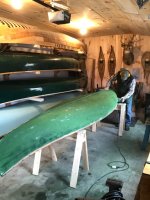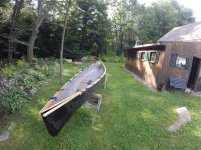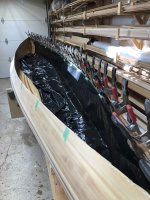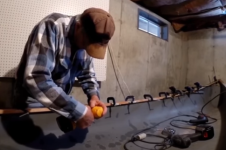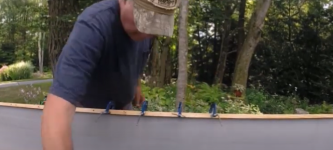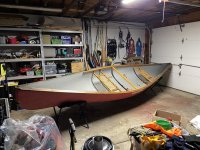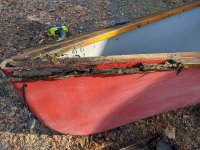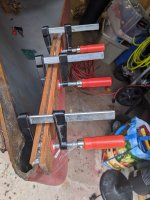Several years ago I picked up a Shopsmith Mark V with the bandsaw attachment. It makes a great sanding station and you'd be hard-pressed to find a less expensive, infinitely variable speed drill press (that can also do horizontal boring). The band saw is "meh". My point is that I get good use out this space saver and they can be had for very little. I do have a dedicated cabinet saw, so that part is not useful for me.
Lol, I almost added "get a Shopsmith Mark V" to my list of useful tools for building a canoe. Now that scratchypants brings it up, I will now proseltize for it.
First the disclaimer: they aren't for everyone. Above all else, to use a Shopsmith you need the ability to plan your work ahead carefully or you will be endlessly frustrated changing back and forth between the various set ups. This is the most common complaint about them. The next biggest complaint is that you need to relearn how to use some of the tools -- most notably the table saw, which I describe below. But once you understand how it works, the Shopsmith is an incredible tool. They pack an unbelievable punch in a small amount of space. And you can do excellent, accurate work on them.
Saying it makes a "great sanding station" is a gross understatement. A lot of people will buy a used Shopsmith and cut them down to length just to set them up as sanding stations. Completely stepless variable speed sanding is, obviously the way to go for sanding and the belt sander and drum sander attachments are great tools that are as good as any on the market and better than most.
But where the Shopsmith truly beats all the competition in the sanding department is as a 12" disc sander. For starters, you have the ability to have separate discs with different grits mounted on them that can swapped out in a matter of seconds. No more changing paper to go between grits or using the wrong grit for the job because you don't want to waste the paper already on the disc. Then there's the tilting table, which is enormous by disc sander standards. And the table has both a real miter gauge and, even rarer, a back up fence (the table saw rip fence). Why would you want a backup fence on a disc sander? Because on the Shopsmith you can unlock the disc and move the sanding disc in and out relative to the work piece during sanding operations and can further pre-set the amount of travel with a depth stop. So, if you back up the work piece with the fence, you now have the ability to disc sand multiple parts to identical, pre-set lengths or widths with absolute, 100% repeatable accuracy. As far as I know, there's no other disc sander on the market you can do this with and until you use and understand this feature and its possibilities, you don't know what you've been missing with your ordinary disc sander. Then there is the conical disc. Trying to explain to the uninitiated what this weird-looking disc does and how it does it is hard. But you know how a disc sander leaves those semi-circular swirl marks across the grain? Well, with the conical sanding disc, there are no swirl marks. The sanding takes place in a narrow, straight line in the direction of the grain. You have to see it to believe it. You can use it edge joint figured woods without tear out and even to edge sand/joint plywood without without dulling/ruining you jointer blades.
As scratchypants mentioned, it is an excellent drill press and one of the few in-home horizontal boring machines out there (horizontal boring is so easy and convenient I rarely use the normal drill press). And it's a very good lathe, too.
Now for the table saw. This is the function most people can't abide on a Shopsmith. The primary complaint about the Shopsmith as a table saw is that, unlike most table saws where you raise and lower the arbor to control depth of cut and tilt the arbor to make bevel cuts, on the Shopsmith you must raise or lower the table to control depth of cut and tilt the table to make bevel cuts. All table saws operated like the Shopsmith until Delta invented the tilting arbor saw. But most people have never operated a table saw that works like the Shopsmith and the very idea of it seems to petrify a lot of people. I must admit, the first time I did it, I thought I would probably injure myself. But once you get used to it, it becomes second nature and works just as and as safely as a tilting arbor saws.
The other big complaint about the Shopsmith table saw is that a lot of people think it is underpowered. Depending on when it was built, the motor is either .75 horsepower or 1.125 horspower. But while it does not have the horsepower of a big cabinet saw, because there is an inverse relationship between torque and rpms and because the Shopsmith is a variable speed table saw, one can dial down the rpms which conversely cranks up the torque. This simple trick allows even the .75 horsepower units to outperform most job-site/table top saws and allows the 1.125 horsepower units to generate more torque than table saws with much greater horsepower (but fixed rpms). But if you need a 3 horsepower (or bigger) cabinet saw, the Shopsmith isn't it.
As for the band saw attachment, I'm not sure why scratchypants rates it only as "meh." It has worked flawlessly for me within its design limitations (6" resaw capacity/12" throat capacity). I have used it to cut strips that were so uniform right off the blade that they were ready to go directly to the router table for beading/coving without any sanding or planing. I also used the band saw to cut my station forms and yokes. Again, stepless variable speed is a useful function for a band saw to cut different species of woods, plastics (and even non-ferrous metals).
Finally, these things are built like tanks and last forever. I am on the Shopsmith Forum and I see people using Shopsmiths Mark Vs made in the 50s when they were first introduced (and an earlier version called the 10ER that were built in the late 40s) and that were passed down from their fathers/grandfathers. Even cheap, used, rust-bucket barn finds on Craigslist can be easily restored, usually just with elbow grease. But spare parts are widely available
Again, they aren't for everyone but they pack a heck of punch in a small workshop.

